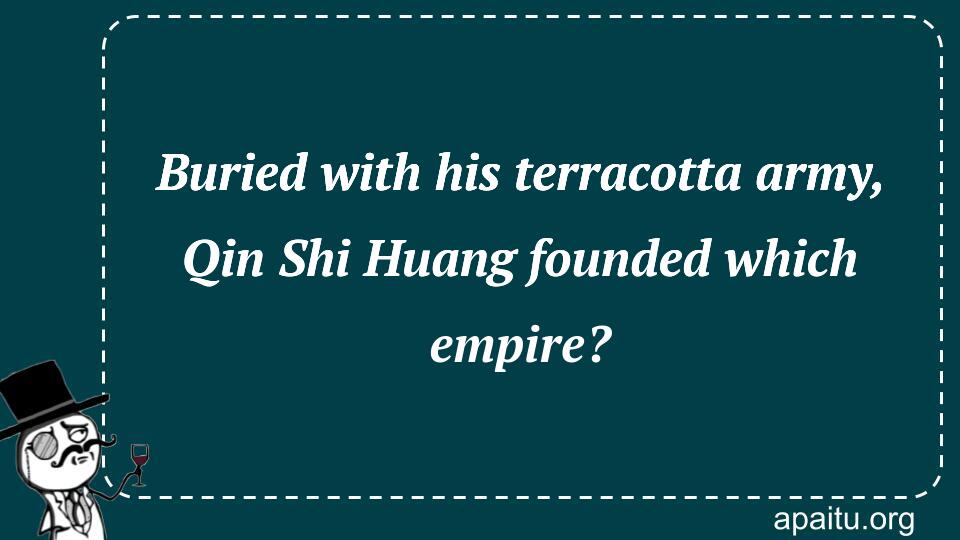Question
Here is the question : BURIED WITH HIS TERRACOTTA ARMY, QIN SHI HUANG FOUNDED WHICH EMPIRE?
Option
Here is the option for the question :
- China
- Japan
- Mongol
- Khmer
The Answer:
And, the answer for the the question is :
Explanation:
Qin Shi Huang was the first Qin dynasty emperor and the first ruler of a united China. For generations, 8,000 life-size terracotta statues, including soldiers and horses, have guarded his tomb. When farmers began drilling for a well in the region in 1974, they accidentally unearthed the tomb. Other items buried within the tomb included wooden chariots, silk, jade, and weaponry.

UNVEILING THE TERRACOTTA ARMY: QIN SHI HUANG AND THE FOUNDATION OF ANCIENT CHINA
In the depths of China’s history lies a remarkable archaeological wonder that continues to captivate the world: the Terracotta Army. This awe-inspiring collection of life-sized statues stands as a testament to the power and vision of Qin Shi Huang, the first emperor of China. Buried alongside him, the Terracotta Army serves as a symbol of the empire he founded, leaving an indelible mark on the course of Chinese history.
Qin Shi Huang, born as Ying Zheng, ascended to the throne at the tender age of 13 in 246 BCE. Through a series of military conquests, he unified the warring states of ancient China, establishing the Qin Dynasty and becoming its first emperor. Eager to assert his authority and solidify his legacy, Qin Shi Huang embarked on ambitious projects that would shape the empire’s future.
One of the most remarkable undertakings of Qin Shi Huang’s reign was the construction of his mausoleum, a vast complex designed to accompany him in the afterlife. Guarding his eternal resting place, the emperor commissioned the creation of an army of terracotta warriors, each carefully crafted and unique, to stand in eternal vigilance.
The Terracotta Army, discovered in 1974 by local farmers in the Shaanxi province, is a testament to the unparalleled craftsmanship and artistic prowess of ancient China. The army consists of thousands of life-sized clay soldiers, horses, and chariots, each painstakingly molded and painted to represent different ranks, weaponry, and facial features. The level of detail and the sheer magnitude of the army is a testament to the grandeur and vision of Qin Shi Huang.
The purpose of the Terracotta Army was twofold. Primarily, it served as a protective force for the emperor in the afterlife, echoing the military might that secured his reign in the mortal world. Each soldier was positioned strategically, ready to defend and accompany Qin Shi Huang in the spiritual realm. Secondly, the army was a display of imperial power, showcasing the might and resources of the Qin Dynasty to both domestic and foreign audiences.
Beyond the Terracotta Army, Qin Shi Huang implemented numerous reforms that left a lasting impact on China. He standardized weights, measures, and currency, unifying the empire and promoting commerce and trade. The emperor also initiated the construction of the Great Wall of China, though it was significantly expanded and fortified by subsequent dynasties. Qin Shi Huang’s reforms laid the foundation for a centralized government, administrative bureaucracy, and cultural unity that would shape China for centuries to come.
Qin Shi Huang’s reign was not without controversy. He adopted strict legalist policies, suppressing dissent and implementing harsh punishments. He also ordered the burning of books and the burying of scholars, seeking to eradicate opposing ideologies and solidify his own philosophy. These actions, while reflecting the emperor’s desire for control and conformity, have been widely criticized throughout history.
The discovery of the Terracotta Army has shed light on the incredible achievements and legacy of Qin Shi Huang. The statues, carefully excavated and preserved, provide valuable insights into the military tactics, artistic techniques, and societal norms of ancient China. Visitors from around the world flock to the Museum of the Terracotta Army in Xi’an, where the statues are displayed, to marvel at the scale and craftsmanship of this archaeological marvel.
The significance of Qin Shi Huang’s empire and the Terracotta Army extends far beyond their historical context. They symbolize the birth of a unified China, a nation that would evolve and endure through millennia of dynasties, conflicts, and cultural transformations. The legacy of Qin Shi Huang’s empire is visible in the modern-day People’s Republic of China, serving as a reminder of the country’s rich history and the resilience of its people.
The Terracotta Army stands as a testament to the vision, ambition, and cultural achievements of Qin Shi Huang and the empire he founded. It is a testament to the enduring legacy of ancient China, inviting visitors to contemplate the remarkable craftsmanship, admire the military might, and reflect on the unifying power of a nation shaped by its past. The Terracotta Army continues to fascinate and inspire, reminding us of the indomitable human spirit and the profound impact of visionary leaders on the course of history.